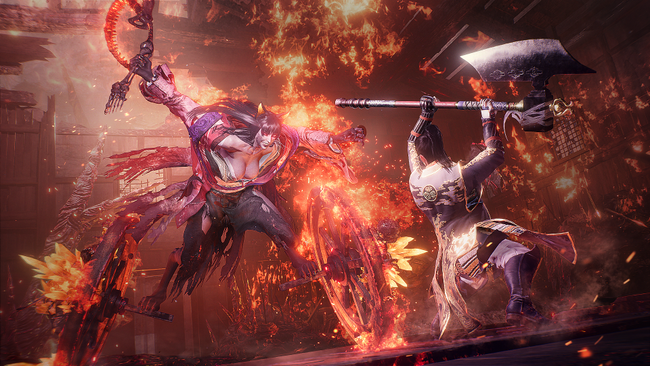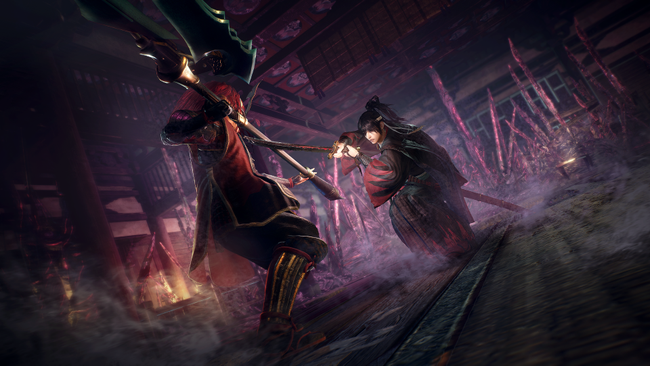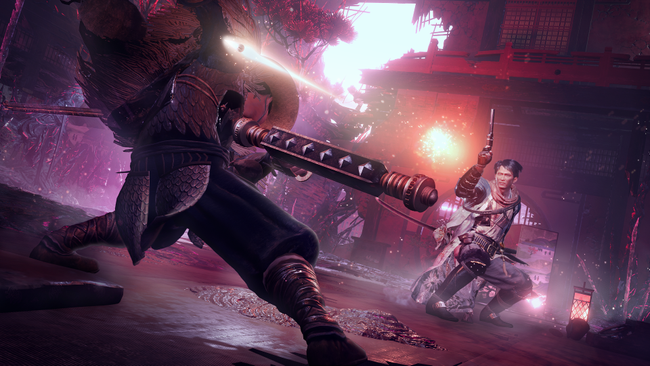
Nioh 3 Interview - Team Ninja talks exploration, difficulty, mascots, and more in the revamped action RPG series
One of the biggest RPGs landing in early 2026 is Nioh 3, coming nearly six years after its predecessor, while adding new gameplay components such as the ninja style and open explorable zones. Nioh 2 was one of RPG Site's top five RPGs of 2020, so we're excited to see what Team Ninja can do in a follow-up that makes some changes to the formula.
Ahead of next year's launch, RPG Site recently had a chance to meet with Fumihiko Yasuda, Development Producer & Head of Team Ninja, as well as Kohei Shibata, Director & Project Manager at Team Ninja, to talk about Nioh 3 and the evolution of the action RPG series. We also discuss difficulty, PC ports, as well as which Nioh mascot is best.
This interview has been slightly edited for clarity.

Fumihiko Yasuda: When we developed Nioh and then Nioh 2, there were about two or three years in terms of the span between the two titles. After that, we thought that there were things that, even though we had focused on the action gameplay side of it, we knew that there was more that we could have done in terms of other gameplay advancements. After creating Nioh 2 and all of its DLCs, we decided to take a bit of a break from the Nioh series until we could come up with the right ideas for a Nioh 3. During that time, we started working on games such as Ninja Gaiden 4 and Rise of the Ronin. As we were working on those titles, the ideas and a proposal for a Nioh 3 did come up.
These ideas were the dual samurai & ninja action gameplay, as well as some elements of an open field. And so I thought, looking at that, these are really big advancements that we can do to the game that would really make it worthy of a Nioh 3. We felt that with the experience that we were gaining from working on all the other titles that Team Ninja was working on, we thought that we would be able to make the best use of them and have something there. It gave me the confidence that we can create the best Nioh game in the series by having all of this latest knowledge and experience within the team.
Kohei Shibata: This time, yes, with the skills, we have made some changes and additions. One of the things that led to this is the open field, since there's a lot of exploration that can take place. You can discover and also gain new skills from exploration. And with the skills themselves, with the skills that you can put in place, obviously there are ones that can help with the base character - that will help increase your defense, help increase your attacks - but also there are also those that are specific to the samurai style and specific to the ninja style that will help you buff those specific areas up. So, there are those things that will help those styles.
If you want to, you can decide, "Oh, I just want to strengthen the samurai style or just strengthen the ninja style". So we leave that up to the player. They have the choice. They don't have to do both. They can have the option of just doing one or the other. But, with the different kinds of skills that you can have for the samurai style and for the ninja style, they can also help accentuate each of those skills.
So, for example, you can be in the samurai style and have a certain buff that you use. And when you switch out to the ninja style, that ninja style can have something that will help increase, even further increase the buff that's not available in just the samurai style. So, we wanted to expand the different options that players will have in terms of putting a character together and also being able to find the combinations that will be right for however the player wants to play the game.

Kohei Shibata: So the theme of the story is 'shogun'. You can think of the shogun as the top of the samurai. Nioh 3 is a story of a character, Takechiyo, who starts out a little bit meek but grows to become the next shogun. At the start of the story, we start at the end of the Sengoku 'Warring States' period of Japan, where the chaos has ended and shifted into a time of peace. After this is the Bakumatsu era, and we're at a time when it is now time to decide who the next shogun should be. The main characters are two brothers who are basically in line to be the shogun.
This is actually based on a historical fact that there actually was, in fact, a pair of brothers who were rivals to become the next shogun around this time. In Nioh 3, we sort of veer away from history, because in actual historical facts, the older brother became shogun. But in Nioh 3, the older brother Takechiyo ends up being tricked by his younger brother, Kunimatsu, who ends up taking the position of shogun.
Since Takechiyo, the older brother, has lost that opportunity of becoming shogun, it is now a story that takes place to see him recover and work to be able to take back that position of shogun from his brother. Takechiyo also gains the ability to traverse through time. In this game itself, we go through the various time periods in Japan that focus on the samurai. We have the Sengoku era, which is where the previous games have been set. That is included again, but also the eras before that, when the concept of samurai first emerged in Japan's history. And then also, as mentioned, we go into the later Bakumatsu era, which is somewhat a time of peace, but still, there are samurai during this time.
So players are able to encounter various samurai and officers from various time periods. And as the main character Takechiyo goes through these various time periods and battles, or becomes allies with certain officers of these times. And that kind of shows his growth throughout the game.
Shibata: (laughs) So, what I'd like to say is, you know, please play the game and look forward to that. But in fact, as I mentioned, the Sengoku period does appear in the game. And that's the period when Ieyasu, his grandfather, happened to live. So there is a part of the story where the two of them interact in some form, but we'll just leave it there for now.

Yasuda: There are two parts to your question, but I do believe it is indeed all one topic at heart. For Nioh 3, from day one, we wanted to have the simultaneous multi-platform launch with PlayStation and PC. And this is something we have done in the past with a title like Wo Long: Fallen Dynasty. So that's something we wanted to do again with Nioh 3. With that, we do recognize that with Wo Long and Rise of the Ronin, initially there were some issues with the Steam versions. In order to make sure we don't have the same mistakes happen again, we are working very closely with our R&D and QA teams to make sure the game comes out in the best possible state on day one.
Shibata: I think the feedback from the alpha demo this time was very positive. In Nioh 3, since we are trying new things like the open field and ninja style, we were curious about how players would accept it. Looking at the reactions we received, people did like it, and it was really encouraging for us to know that these things that players enjoyed. Of course, we received a lot of other useful feedback that helped out with our development.
To give you a few examples, we were able to create the new ninja style this time. In previous games, we made it so you could switch between two weapons. Initially, we felt that being able to switch weapons and switch styles might be a bit too complicated or convoluted for some people, so we decided to take out the ability to switch between two weapons. However, we received a lot of feedback that those who had played the series in the past also wanted the ability to switch weapons, on top of being able to switch styles, so we decided to make that an available option in the game once again.
You actually don't need to switch between weapons to clear the game, but the option is there for those who want to make use of it. That's an example of one such feedback we got from the alpha demo.In the past, we've received a lot of feedback about types of things people wanted to see in previous games that we weren't able to do before, and some of those things we've now been able to incorporate into Nioh 3 as well.
Yasuda: Rise of the Ronin was an open-world game that took place in nineteenth-century Japan, and really, the goal of the game was to experience that place and time in the world. So, that was a bit of a different approach than what we want to do with Nioh 3, but in terms of the game design and the technical aspects, there were a lot of things that we were able to take from the experience of developing Rise of the Ronin. I think some of the feedback that we also received for Rise of the Ronin was that we relied too much on UI, and some parts of the game were a little bit repetitive. From that, we wanted to make sure that we would improve on those points for this game as well. Nioh 3 itself wasn't something that we started from scratch, unlike Rise of the Ronin, which was a completely new game.
Obviously, Nioh 3 has the base of Nioh 2, so we wanted to work on top of that and make sure that since we were incorporating the open field, we wanted to make sure that the game didn't feel too linear or closed off, so we wanted to make sure that we were careful about those aspects. But at the same time, making sure that there was that density and that sense of tension that has been in the Nioh series, and we wanted to make sure we didn't lose those aspects. So it was that balance to make sure that we would retain. Obviously, the two games are different, but there were things that we were able to learn from Rise of the Ronin that we incorporated into the development of this game.

Yasuda: (laughs) I was the director of 1 and 2, so it has to be either Kodama or Scampuss. But I think Scampuss is my favorite.
Shibata: Not just because I'm the producer of Nioh 3, but I do like Chijiko. I think it's quite cute in its appearance. It's also a yokai that we were able to incorporate because of the more three-dimensional elements of the field this time around. So when exploring the open fields, if you start to hear the ringing of its bells, then you know that there's one nearby, and so you look up and see if it's there. So I think Chijiko definitely adds an accent to the game, and I do like its design.
Yasuda: For the Nioh series, difficulty options are something we are not considering. There is only one set difficulty. The reason behind this is that we want to make sure that the game has its challenges, but at the same time, we felt there is value in feeling that sense of satisfaction when you overcome those difficulties. And throughout the game, we are not making it impossible. We are making sure that there are ways to grow your character and have options to clear hurdles. There are side missions you can take to level up your characters, or you can team up in online multiplayer to have the opportunity to be able to clear these stages.
So we're not closing off any opportunities of being able to clear the game, and there are many different kinds of possibilities ... there is a high degree of freedom for each person to figure out the way that works for them to clear the game. So we want to make sure that, in a way, options are available, but at the same time, we don't plan on having a difficulty setting.
That being said, yes, Rise of the Ronin, Final Fantasy Origin: Stranger of Paradise, and the Ninja Gaiden series all have difficulty settings for various reasons. So it's not that we're against having difficulty options, but just specifically for the Nioh series, I think from a design aspect of it, we don't plan on adding any difficulty options. Also, Nioh 3 is an open-field game; it does provide the opportunity, if you are stuck somewhere, you can take a side trip to help open up options to help yourself out. We've given options to clear challenges without having a difficulty setting. So we're going to plan on sticking with just the single difficulty.
RPG Site: Thank you for your time.
Nioh 3 is set to release on February 6 for PlayStation 5 and PC.